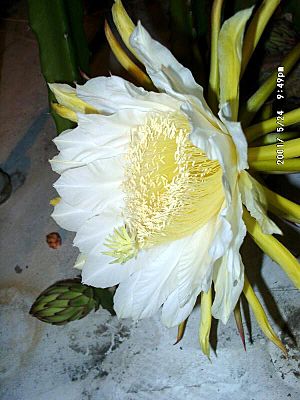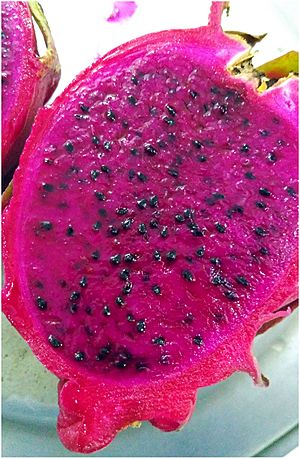Red-fleshed pitahaya facts for kids
Quick facts for kids Red-fleshed pitahaya |
|
|---|---|
 |
|
| Conservation status | |
| Scientific classification | |
| Genus: |
Selenicereus
|
| Species: |
costaricensis
|
The Selenicereus costaricensis, also known as the Costa Rican pitahaya or Costa Rica nightblooming cactus, is a type of cactus. It is native to countries like Costa Rica, Panama, and Nicaragua. This plant is famous for its bright, colorful fruit, often called pitaya or pitahaya. People also grow it as a beautiful ornamental vine because it has very large, impressive flowers. Scientists are still studying if this plant is truly different from another similar cactus called Selenicereus monacanthus.
Contents
About the Red-Fleshed Pitahaya
This cactus has stems that can climb, like a vine. They are usually thick, about 1 to 3 centimeters wide, but can grow up to 10 centimeters wide. The stems often have three (sometimes four) ridges. Along these ridges, you'll find small, woolly spots called areoles. These spots have short, dark spines, usually 3 to 6 of them, which are about 2 to 4 millimeters long. The skin of the stem is a grayish-green color.
Flowers
The flowers of the pitahaya are shaped like a funnel and are quite large, growing 22 to 30 centimeters long. They have a strong, pleasant smell. When they are young, the flower buds look like small balls. The flowers have many narrow, leaf-like parts called bracteoles. The outer parts of the flower are greenish-yellow, while the inner parts are white. The flowers bloom in the summer or autumn.
Fruit
The fruit of the pitahaya is round or egg-shaped. It is a bright, beautiful magenta color on the outside. Inside, the fruit has purple flesh, which is why it's called "red-fleshed pitahaya." The fruit contains small, black, pear-shaped seeds, about 10 millimeters long.
Plant Names and Science
The scientific name of this plant has been a bit tricky for scientists. In 1902, a scientist named Frédéric Weber first described it. He called it Cereus trigonus var. costaricensis. The name costaricensis comes from Costa Rica, where the plant grows naturally. Weber noted that this plant had a triangular stem and a fruit with crimson (dark red) pulp that tasted very good. People in Costa Rica really liked this fruit, calling it pitahaya.
Later, in 1909, other scientists moved this plant to a different group, or genus, called Hylocereus. They gave it the full species name Hylocereus costaricensis.
More recently, in 2017, new studies showed that the Hylocereus group actually fits inside another group called Selenicereus. Because of this, all the plants from Hylocereus were moved into Selenicereus. So, Hylocereus costaricensis became Selenicereus costaricensis. Scientists are still working to fully understand how this plant is related to other similar cacti.
Where It Grows
This plant naturally grows in Costa Rica, Nicaragua, Panama, and Peru. However, it has been grown in so many places that it's hard to know its exact original home. It likes to grow in dry forests near the coast, from sea level up to about 1,400 meters high.
How to Grow It
The red-fleshed pitahaya is an epiphyte or xerophyte, which means it can grow on other plants or in dry conditions. It's quite easy to grow and grows quickly.
- Soil: It needs soil that has a lot of humus, which is rich, dark organic material.
- Water: It needs enough moisture during the summer months.
- Temperature: In winter, it should not be kept in temperatures below 10 °C (50 °F).
- Sunlight: You can grow it in partial shade or full sun. Giving it extra light in early spring can help it produce more flower buds.
- Flowering: Its beautiful flowers usually bloom in the summer or autumn.
See also
 In Spanish: Hylocereus costaricensis para niños
In Spanish: Hylocereus costaricensis para niños



